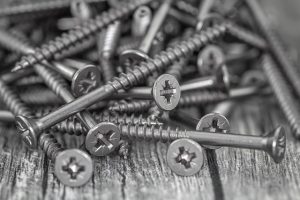
Have you ever tried to remove a screw, only for your screwdriver to spin freely in the screw’s head? Most screws have a recess in the head. You can tighten or loosen them by placing a screwdriver in this recess and turning it in the respective direction. If the screw is stripped, however, your screwdriver will spin freely without actually gripping the screw’s head.
Corrosion
Corrosion can cause stripped screws. Most screws are made of steel. As an iron alloy, steel is strong — but it’s also susceptible to corrosion when exposed to moisture. If the head begins to corrode, it may no longer provide a uniform and stable recess for your screwdriver.
Over-Tightening
One of the most common causes of stripped screws is over-tightening. You can tighten screws, of course, by turning them clockwise with a screwdriver. Once the head becomes flush with the surface of the object in which it’s installed, though, you should typically stop. Continuing to turn the screw may strip it.
Wrong Screwdriver
Another common cause of stripped screws is using the wrong screwdriver. If the screw has a Phillips head recess, for instance, you should use a Phillips head screwdriver. If the screw has a slotted recess, you should use a slotted or flat-head screwdriver. At the same time, the screwdriver should be the appropriate size for the screw’s recess. Using a screwdriver that’s too big or too small will increase the risk of stripping.
Cheap Screws
Cheap screws are more likely to strip than their high-quality counterparts. Stripped screws are characterized by a worn, degraded head recess. Rather than being solid and intact, they have a worn-down head recess. If a screw is made of cheap, low-quality materials, it may quickly degrade. You can avoid stripped screws and similar headaches by investing in high-quality screws.
Improper Tightening
Improper tightening is a common cause of stripped screws. Whether you’re using a Phillips head or flat-head screwdriver, you should push forward. In other words, your screwdriver should be directly in front of the screw as you push and turn it. If you push to the side, you’ll inadvertently wear down the screw’s head recess, thus increasing the risk of stripping.
Installing in Soft Materials
Installing screws in soft materials can make them susceptible to stripping. The screws will encounter less resistance when driven into soft materials. While this makes them easier to install, it also places them at risk for stripping.
